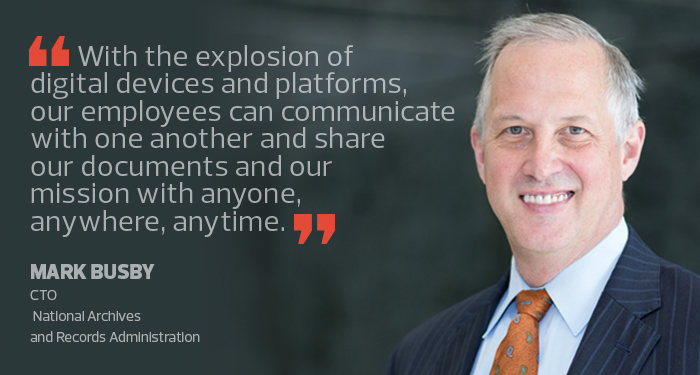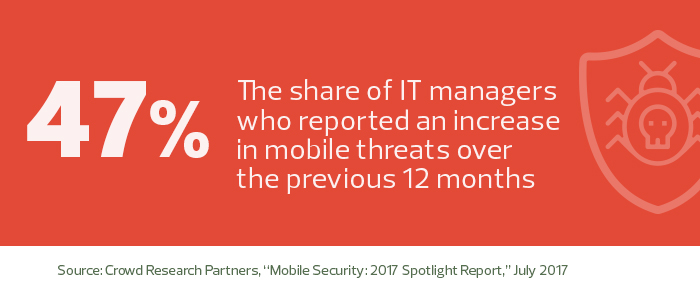sponsor content What's this?
Even the Most Tight-Lipped Agencies Need Wi-Fi

Presented by
FedTech

Wireless networking is popping up in a place employees never expected to find it: federal buildings.
Not long ago, federal leaders could refrain from offering wireless networks in their buildings and simply point to security risks as the reason.
That time has passed.
Today, mobile devices and their corresponding applications are too prevalent to ignore. Even those agencies that deal with sensitive data and were most resistant to Wi-Fi are nowreconsidering their stance. The Pentagon began installing wireless access points in early 2016. The National Geospatial-Intelligence Agency, for example, set up a designated area where workers could bring their mobile devices to work on a specific project that didn’t require access to classified data.
Federal IT leaders say they’re adopting wireless solutions to achieve the same benefits — increased productivity and collaboration — long cited by their peers in other sectors. But, by adding wireless connectivity, they’re also responding to demands from their own employees.
“The younger generation has a penchant for mobile devices,” says William Kronzer, workforce services and development executive for the Defense Information Systems Agency. “We hear it through the recruitment process. We also hear it internally. Employees want to be more mobile.”
DISA has deployed Wi-Fi throughout the nonclassified spaces at its Fort Meade headquarters in Maryland and created 434 access points. Using wireless components from Aruba Networkspurchased in 2016, employees can connect to the DISANet network from any enabled laptop.
Today, the agency averages about 550 users per day on its wireless networks. It also supports wireless solutions throughout the Defense Department.
“Defense employees are just like everybody else in the rest of the world,” says Jake Marcellus, DISA’s mobility portfolio manager. “Smart devices are 9 years old. Everybody uses them in their personal life, and they have created new expectations with respect to a mobile workforce.”
Workers See Productivity Gains with Wireless
As agency leaders consider mobility solutions, Kronzer says, they will likely find widespread benefits for employees.
“It speeds up decision-making and increases productivity,” he says. “It provides the workforce more flexibility, particularly when it comes to continuity of operations and continuity of government. It allows people to work at different locations, which impacts our ability to react to emergencies. It also provides employees more capabilities to telework.”

Jason Martin, DISA’s services executive, says the agency now supports mobile solutions for its most senior leaders, including those who trade in classified information. “Sometimes, you’ve got to go home,” he says. “In the past, you would have to drive into the office to perform work tasks. With mobile devices that can process classified data, now those leaders might be able to do some things while they’re traveling, or at home.”
DISA workers leverage the latest commercial technology from Verizon, AT&T, Sprint and T-Mobile using mobile devices that run the Android and iOS operating systems.
Andrew Hewitt, an analyst at Forrester, says that employees want the freedom to use whatever device makes them most productive. Now, many agencies are looking to support devices and to give their workers an edge.
“Mobile enablement for employees comes with all sorts of business benefits, including higher productivity, higher employee happiness, a willingness to recommend the company and its products to friends and family, and more career-driven behavior,” he says.
Mark Busby, CTO for the National Archives and Records Administration, says the agency supports mobility, including a cloud-based email service through Google Apps for Government, to improve flexibility. “With the explosion of digital devices and platforms, our employees can communicate with one another and share our documents and our mission with anyone, anywhere, anytime,” he says.
That practice is becoming more common. David Harrity, associate CIO for enterprise infrastructure and operations at the General Services Administration, says nearly all IT initiatives there now include a mobility component. While a few years ago most agencies used the devices for simple functions, common capabilities now include the ability to review documents, search for information and use maps.
“This is critical to keeping our employees more productive and to recruiting a workforce from several age groups,” Harrity says. “It allows hiring managers to recruit the best candidates from across the country, rather than only considering the D.C. metro area when looking for the best talent.”
Mobility Brings Flexibility, Challenges
The chief benefit of enhanced mobility for agencies is that workers can share and present information from anywhere, rather than being tethered to their desks, Martin says. This means avoiding in-person scheduling nightmares and making it easier to meet deadlines.
“Being able to present real-time data from a remote location is where we’re seeing the value,” he says. “We’re seeing people work from almost anywhere.”

However, deploying mobile solutions is more sophisticated than it was years ago. Simply rolling out devices or offering employees access to Wi-Fi and basic productivity apps is likely to be unsatisfying for most workers. One challenge is to create and deploy custom apps that provide value, protect data and are easy to use.
“There’s an expectation with mobile applications that you shouldn’t have to figure out how it works,” Marcellus says. “There’s inherent efficiency in mobile interfaces that the commercial world has grasped. The Department of Defense is leveraging those same enhancements.”
Security Remains a Top Priority in Wireless Deployments
Historically, security concerns have held some agencies back from adopting mobile solutions. It’s still at the forefront of IT administrators’ minds. But strong security standards have led many agencies to treat mobility like any other IT resource — as something to be protected, not to be avoided.
“Security is the foundation of everything we do,” says Marcellus. “Our starting point is always taking security standards and layering capabilities on top of those. The security in mobile solutions is baked in.”
Hewitt argues that while mobile initiatives such as BYOD programs can introduce vulnerabilities, Wi-Fi is no more dangerous than wired networks if organizations follow standard security practices. “Wired is far more targeted by attackers than wireless,” he adds.
At GSA, balancing security with user experience is more challenging than in the past, Harrity says. Previously, organizations often required users to sign in to their device separately from specific apps. Enterprise mobility management tools with secure single sign-on capabilities, such as IBM’s MaaS360 service, have reduced that burden. The Commerce, Labor and Interior departments have adopted a similar approach.
Still, he notes, it’s important to monitor threats and vulnerabilities to reduce unauthorized access.
Years ago, agencies weren’t having those conversations. Today, CIOs can have wireless capabilities on their terms, meaning they can boost productivity without compromising security.
This content is made possible by FedTech. The editorial staff of Nextgov was not involved in its preparation.


